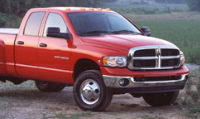'06 Ram stops with 4X4 engaged
#41
Ok, first things first. If you engage 4 wheel drive, what you are doing is locking both the front and differentials together. That means the front and read *DRIVESHAFTS* are locked together, and both ring and pinions want to spin the same speed. Keep this in mind.
Now, visualize a turn. The front of the truck drives through the turn, and the rear more or less pivots, traveling a shorter distance than the front axle. This means the front differential will rotate, or spin, more than the rear one will. In 2 wheel drive, the front driveshaft is disconnected so this is no big deal.
In 4 wheel drive, however, now you have a problem, especially on high-traction surfaces. Because the front and rear driveshafts are locked together, which locks the front and rear differentials together, when you turn, the front differential will try and spin more than the rear one, but it won't be able to, which causes everything to bind up. That is what is causing your truck to stop when you try to turn on dry pavement. This has nothing to do with limited slip differentials. 4 wheel drive does not 'lock' your differentials, and it does not only drive one wheel in the front and one in the rear. It distributes the power 50-50 to the front and rear differentials. What the differentials do with the power is something else.
Here's a site that explains it a bit better: http://www.4x4abc.com/4WD101/
On another note, will you guys that really don't have any idea what the hell you are talking about stop guessing and typing it up like you do? You aren't impressing anyone; what you're doing is spreading misinformation and confusing the folks who are really looking for answers.
Now, visualize a turn. The front of the truck drives through the turn, and the rear more or less pivots, traveling a shorter distance than the front axle. This means the front differential will rotate, or spin, more than the rear one will. In 2 wheel drive, the front driveshaft is disconnected so this is no big deal.
In 4 wheel drive, however, now you have a problem, especially on high-traction surfaces. Because the front and rear driveshafts are locked together, which locks the front and rear differentials together, when you turn, the front differential will try and spin more than the rear one, but it won't be able to, which causes everything to bind up. That is what is causing your truck to stop when you try to turn on dry pavement. This has nothing to do with limited slip differentials. 4 wheel drive does not 'lock' your differentials, and it does not only drive one wheel in the front and one in the rear. It distributes the power 50-50 to the front and rear differentials. What the differentials do with the power is something else.
Here's a site that explains it a bit better: http://www.4x4abc.com/4WD101/
On another note, will you guys that really don't have any idea what the hell you are talking about stop guessing and typing it up like you do? You aren't impressing anyone; what you're doing is spreading misinformation and confusing the folks who are really looking for answers.
#45
TheChad- Hummers use an LSD as well. Actually it uses one of the best LSD'sever designed, it uses the Gleason-Torsen, a gear driven LSD that provides excellant traction. Audi uses them as well. As for your other questions, first, sit-down and read your owner's manual, then if you still don't understand, ask us. For all of you, in our trucks, there is no reason to put in 4wd to lubricate anything. Your manual doesn't tell you to, does it? It's something someone told you or you read in your old '85 ford manualWe do not have hubs that lock and unlock so our front-end is always spinning keeping the gears lubricated. That is something that was passed down from "old-school" systems where the front hubs would spin and the axles/diff/pinion/drShaft did not. Also, believe it or not the "****" shifter on our trucks works differently then the "lever" shifter does.
Kenhemi explained it all very well, and to answer the next question: AWD basically means that there is a "differential" between the front and rear to allow them to spin at different speeds thereby allowing you to leave it in AWD all the time. Key pointto AWD is that they do not have a low range.For snowy/slick roads AWD will be better then 4wd because it only sends power forward when the rear starts to spin. I only use 4wd on very slick/muddy roads when the rear spins. Once I'm on dry dirt, back to 2wd. Hardly ever in the winter, only to get up an unplowed hill but that is it. Personnally, I think 4wd in snow is dangerous because people get overconfident in the traction abilities of thier vehicles. 4wd will not make you stop quicker
Kenhemi explained it all very well, and to answer the next question: AWD basically means that there is a "differential" between the front and rear to allow them to spin at different speeds thereby allowing you to leave it in AWD all the time. Key pointto AWD is that they do not have a low range.For snowy/slick roads AWD will be better then 4wd because it only sends power forward when the rear starts to spin. I only use 4wd on very slick/muddy roads when the rear spins. Once I'm on dry dirt, back to 2wd. Hardly ever in the winter, only to get up an unplowed hill but that is it. Personnally, I think 4wd in snow is dangerous because people get overconfident in the traction abilities of thier vehicles. 4wd will not make you stop quicker




